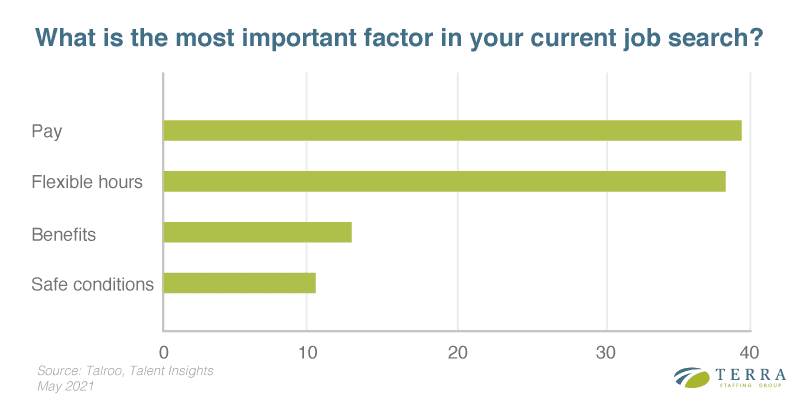Hire Like a Pro: What Staffing Experts Look for in Quality Candidates
Posted on January 12, 2022
Finding quality candidates to fill open positions has always been a challenge. According to data compiled from “The America Works Report: Quantifying the Nation’s Workforce Crisis” by the U.S. Chamber of Commerce, there is a shortage of qualified workers on the job market, which makes recruiting talent harder than ever. The same report found that 90% of industry association economists say employers are struggling to find qualified workers for open jobs. The situation may also contribute to retention challenges as skilled workers are lured away from their current roles. Rising wages and more work opportunities creates a competitive talent market, which means HR professionals need to be more strategic to attract the right talent.
The combined result of shortages and turnover can leave a company struggling to keep up with daily operations and unable to grow.
According to a recent survey by the National Federation of Independent Business, 49% of business owners say they have unfilled job openings. Talent shortages, among other hiring challenges, have left companies eager to attract and hire great people for their teams. The problem places more emphasis on the need to improve every step of the hiring cycle, including sourcing, screening, and onboarding candidates.
Fortunately, HR professionals can attract the right talent with the following strategies:
Make Effective Job Postings
A well-crafted and detailed job posting serves multiple purposes. For HR professionals, it defines the type of candidate that could be successful in the role. For the candidate, it offers key details regarding the skills and responsibilities of the role. A disorganized job posting makes a company appear unprofessional. If it includes a long list of responsibilities, it could mean unrealistic expectations. Take a critical look at your job postings to ensure you’re not missing out on quality candidates.
Some tips for effective job postings include:
- Use a clear job title: Avoid using trendy phrases that don’t really describe the role. “Rockstar community wrangler” may sound catchy, but “social media manager over community engagement” is far more descriptive. It will also help people with relevant experience find your job more easily.
- Use standard terms to describe experience levels: Instead of saying you need someone that is “very experienced,” say you’re looking for a senior-level employee with over five years of relevant experience.
- List the realistic minimum requirements to be considered for the position: You won’t be able to find someone with a master’s degree and ten years of experience for a position that pays a junior-level salary.
- Clearly define responsibilities: Provide specifics about the day-to-day responsibilities of the role, and make sure they align with job se ekers’ expectations. You can get a quick snapshot of industry standards by looking for job postings for similar roles.
Watch our Webinar: Winning More Talent — It’s an Inside Job
There is no doubt that recruiting is on the top of every business leader’s mind and priorities at the moment. With an economy that is showing robust signs of recovery, talent in short supply and epidemic levels of turnover, the talent challenges of the past seem like child’s play compared to the current market.
In this session, we will discuss the current talent market, important changes in recruiting strategy and important tactics for any company who wants to win.
Treat Talent as a Customer
Often, HR professionals treat candidates impersonally, which shows in the quality of their applicants. To attract the right candidates, treat talent more like customers than applicants. Think of the way a salesperson pitches a product or service to a prospective client—It’s much more involved than listing basic information on a site and waiting for the sales to arrive.
HR professionals can attract more talent if they “sell” the benefits of working for your organization and nurturing candidates into application. The following aspects of employment are the biggest motivators for potential candidates:
- Pay: 39%
- Flexible hours: 37%
- Benefits: 13%
- Safe conditions: 11%
Source: Talroo, Talent Insights May 2021
Though pay is still the biggest draw for potential candidates, flexible hours have seen significant growth in the past years. Fractl conducted a survey of 2,000 job seekers and found that more flexible hours was a consideration for roughly 90% of respondents. That said, different industries have different concerns. Know what your target applicants are looking for, and cater your messaging to speak to their priorities.
To create candidate-centric job postings, be sure to:
- Think like the job seeker
- Convey your value proposition
- Highlight real-world successes
- Market test with your own team
To create a candidate-centric apply process:
- Mobile-first is a must
- Audit your own apply process
- Consider the implications of virtual interviews
- Think relationship vs. transaction
What to Look for in a Job Candidate
When you look for candidates, you’re not just looking for someone that can do the job. You are looking for someone that has the skills, attitude and drive to be successful at your organization. You are also trying to match a company’s culture with the personalities of the applicants in order to keep job satisfaction high and turnover low.
Trying to strike a balance between all of these needs can be daunting, but it’s worth the extra consideration. Start by asking yourself the following questions as you evaluate potential candidates:
Are they a culture fit?
Have you defined your company culture? Before you can establish whether or not a candidate is a good culture fit, you’ll need to establish your organization’s values, traditions, and core principles. A company’s culture is often vague, and defining it can help guide your candidate search.
A candidate is a culture fit when their beliefs, values, and actions align with your organization. Culture fit can be observed during in-person or virtual interviews, through email correspondence, or through their personal pursuits or volunteer work outside of work. The traits you see can indicate if someone is a culture fit for your organization.
Keep in mind that culture fit is not synonymous with job fit. For instance, someone that doesn’t enjoy talking with people may not be happy in a position that requires plenty of customer interaction. That may make them a poor fit for a particular job, but that doesn’t mean they are a poor fit for the culture.
Culture goes both ways. The concept of company culture was not always considered a part of a quality candidate’s makeup, but that has changed in recent years and research indicates that job candidates are also looking for a company culture that is a good fit for them. Having a positive working environment can help improve worker satisfaction and increase employee retention. Job-seekers now understand the importance of company culture in their job searches, so make sure you’re communicating what your company is all about.
The potential challenges of culture fit
Though culture fitness can be a powerful positive force for an organization, it may also promote conformity and a lack of diversity. It’s important for organizations to get out of their comfort zones and welcome a broad set of personalities and ideas. Connecting with like-minded candidates seems like a natural choice, however it may promote negative values including exclusivity, bias, and homogeneity.
“An ill-defined company culture can slip into unhealthy habits, such as favoring job candidates who laugh at your jokes or cheer for your favorite team. Subjective employment criteria set the stage for awkward speculation about the “real reasons” for your company’s hiring choices.” –Jenifer Lambert, Chief Strategy Officer, TERRA Staffing Group
When company culture is working for your organization, it’s inclusive and promotes the company’s mission. Though ensuring values are aligned, ensure your organization is hiring to promote a diverse set of backgrounds, perspectives, and experiences.
Do they have the right skills, education and experience?
Every role has a core set of skills that are needed to be successful, which are the prerequisite skills needed to be considered for the position. Additionally, there are peripheral skills that can contribute to the candidate’s success in the position. These skills often indicate a candidate’s potential for growth. Be sure to consider the full scope of a candidate’s skills to ensure you hire the right applicant.
In addition to skills, make sure the candidate has a solid understanding of the education and experience needed. In particular, determine if there is any flexibility allowed in evaluating a candidate’s qualifications. If the role’s job description requires an undergraduate degree, would you consider an applicant that doesn’t have a degree but has years of demonstrable experience?
Do they value learning?
Curiosity and a strong interest in continued education could indicate a high-quality candidate. Not only is it a sign that the person enjoys their field and wants to grow, it also shows their ability to adapt. This doesn’t necessarily refer to going back to school, earning degrees or certifications. Candidates show their interest in learning and growth in many different ways. Look for people with a diverse work history, progressive job titles and demonstrated ability to learn and gain new skills.
Are they good communicators?
Communication is important, but can be vital in certain positions. Each candidate has different communication styles, and some jobs require different means of communication. For example, the ability to write well may be necessary for some roles, while other roles really only require strong verbal skills. Your goal is to match the style of communication needed with a candidate’s skill.
It’s also important to evaluate communication skills relative to the job they’re applying for. All jobs offer some form of communication, but there is a huge difference between face-to-face communication, email and team chat, internal systems, and other forms of workplace communication. Ensure their communication style and skills are matched to the job at hand.
Download our eBook: Everything You Need to Know About Manufacturing Staffing
Discover the historical context, recent data, and best practices for staffing manufacturing jobs in America. Download our eBook, “Everything You Need to Know About Manufacturing Staffing” for data-driven strategies for staffing manufacturing jobs.
Looking Beyond the Resume
A resume isn’t the only way to get information on a potential candidate. In fact, you can’t truly evaluate anyone from their resume alone. Look deeper into candidates by checking out their profile and activity on a professional outlet like LinkedIn. Look into their work history, posts, and the types of recommendations that appear on their profile page.
You can also send a short introduction email and arrange a brief phone call. This can help you gauge their interest and get a glimpse of their personality and communication style. Just make sure you communicate you’re trying to fill a position and provide them the title of the role. If they aren’t interested, they may be able to point you in the direction of other qualified candidates.
Where to Find Quality Candidates
fFinding the right candidates for your organization can be a major challenge in a competitive job market. With so many companies on the lookout for talent, you have to be vigilant and creative to attract strong candidates. Be sure to use the following platforms and avenues to find the right candidates for your open positions:
- Professional social platforms like LinkedIn and Glassdoor
- Professional networking events, meetups, and conferences
- Expanded your search to additional online communities like Quora or Reddit
- Your current and past talent pool to refer people from their own networks
You can also post the position on your personal and professional social networks. Let everyone know that you’re looking for talent and ask them to share the post with their own network. This can quickly put you in front of an entirely new group of people that may be on the lookout for their next great opportunity.
Additionally, you can also get professional recruiting and staffing help. This can be especially helpful for administrative, accounting, industrial, technical and professional roles that are otherwise difficult to fill.
Categories: HR and Management Advice, Staffing Tips & Recruiting Trends
Tags:








